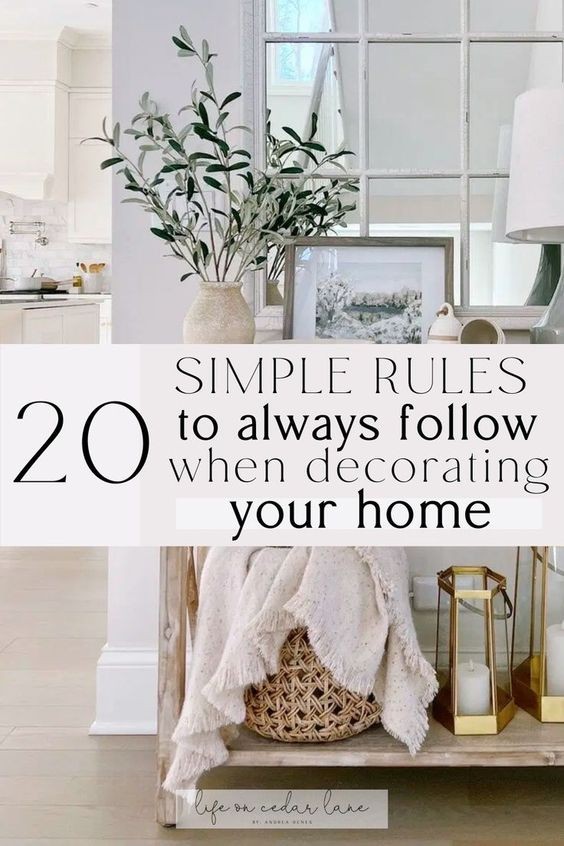Essential Interior Design Rules You Must Follow for Perfect Home Decor
Creating a beautifully designed home is a blend of art and science. While personal style and creativity play a huge role, adhering to some essential interior design rules can ensure that your space is not only stylish but also functional and harmonious. Whether you're redecorating a single room or overhauling your entire home, these rules will guide you toward achieving the perfect home decor.
1. Understand the Importance of Balance
Balance is fundamental in interior design. It involves distributing visual weight within a room to achieve a sense of equilibrium. There are three types of balance to consider:
Symmetrical Balance: Achieved by mirroring elements on either side of a central point, such as placing identical lamps on either side of a sofa. This method creates a formal and orderly appearance.
Asymmetrical Balance: Involves arranging different elements of equal visual weight to achieve a more dynamic and casual look. For example, pairing a large piece of art with a grouping of smaller items can create balance without being identical.
Radial Balance: Arranges items around a central focal point, like a round dining table surrounded by chairs. This type of balance works well in spaces designed around a central feature.
2. Master the Art of Proportion and Scale
Proportion and scale are crucial for creating a cohesive and comfortable space. Proportion refers to the size relationship between objects, while scale is about the size of an object in relation to the room or space.
Choose Appropriately Sized Furniture: Large rooms can handle oversized furniture, while smaller spaces benefit from more compact pieces. Avoid overcrowding a room with furniture that is too large or using pieces that are too small for the space.
Consider Ceiling Height: High ceilings can accommodate taller furniture and larger art pieces, while lower ceilings might require lower-profile furniture to avoid overwhelming the space.
3. Establish a Focal Point
Every room needs a focal point—an area or feature that draws the eye and anchors the space. This could be a fireplace, a piece of artwork, a stunning piece of furniture, or a large window with a view.
Highlight the Focal Point: Arrange other elements in the room to complement and enhance the focal point. For example, if your focal point is a fireplace, arrange seating around it to encourage conversation and create a natural gathering spot.
Avoid Multiple Focal Points: Too many competing focal points can create visual clutter. Stick to one main focal point and arrange other elements to support it.
4. Achieve Harmony and Unity
Harmony and unity ensure that all elements within a room work together to create a cohesive look. Harmony is achieved by using similar colors, patterns, or styles, while unity involves tying together different elements to create a consistent theme.
Use a Consistent Color Palette: Choose a color scheme that complements your space and stick with it throughout the room. This can include wall colors, furniture, textiles, and accessories.
Incorporate Repeating Patterns: Patterns and textures that repeat in various elements of the room, such as rugs, pillows, and curtains, help to create a unified look.
5. Prioritize Functionality
While aesthetics are important, functionality should never be sacrificed. A beautifully designed space is also practical and suits the needs of those who live in it.
Plan for Traffic Flow: Ensure that furniture arrangement allows for easy movement and does not obstruct pathways. A well-planned layout makes the room more functional and comfortable.
Consider Storage Solutions: Incorporate practical storage options to keep the space organized and clutter-free. Built-in shelves, multi-functional furniture, and clever storage solutions can enhance both style and function.
6. Play with Texture and Layering
Texture adds depth and interest to a room. Layering different textures can create a more inviting and dynamic space.
Combine Materials: Mix materials like wood, metal, glass, and textiles to add variety and richness. For example, pair a plush velvet sofa with a sleek glass coffee table.
Layer Textiles: Use rugs, cushions, throws, and curtains to introduce different textures and patterns. Layering textiles can make a space feel cozier and more personalized.
7. Get the Lighting Right
Lighting is essential for both functionality and ambiance. A well-lit room not only looks better but also serves its purpose effectively.
Use a Mix of Lighting Types: Combine ambient lighting (overhead lights), task lighting (reading lamps), and accent lighting (spotlights or wall sconces) to create a balanced and versatile lighting scheme.
Adjust Lighting for Mood: Dimmer switches and adjustable lighting options allow you to tailor the lighting to different activities and moods.
Conclusion
Following these essential interior design rules can help you create a space that is not only aesthetically pleasing but also functional and harmonious. By understanding balance, proportion, and scale, establishing focal points, achieving harmony and unity, prioritizing functionality, and playing with texture and lighting, you'll be well on your way to designing a home that is both stylish and livable. Remember, great design is about creating spaces that reflect your personal style while also meeting your practical needs.






